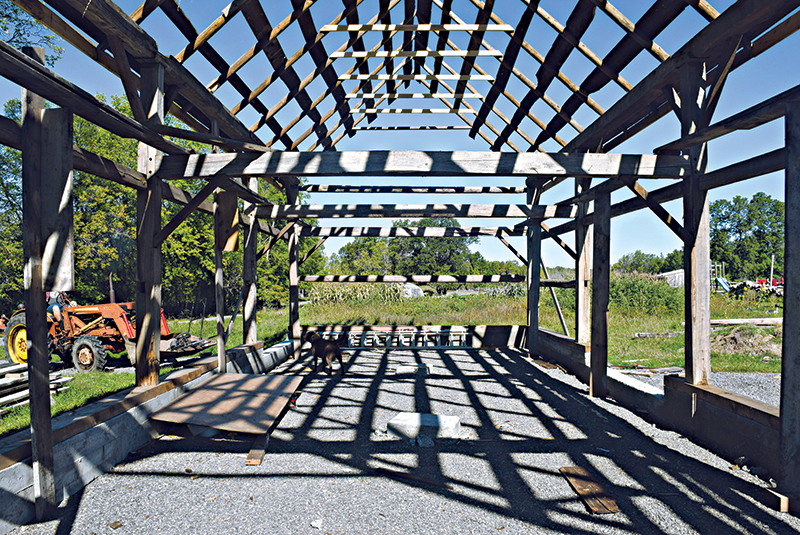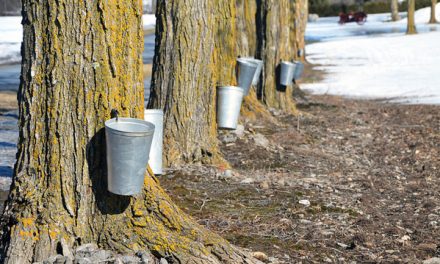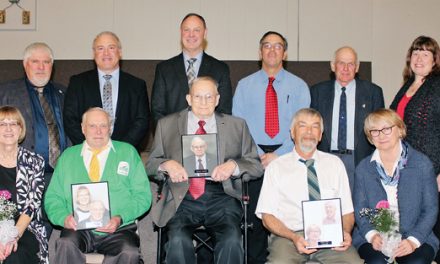This is a look from the inside of the barn in the early days of its construction. Morin Photo
The old, can often become the new.
Mixing the past with the present and honouring the people who came before us all, feature in a Montague Township couple’s decision to repurpose the wood from a hundred-year-old carriage house into their new multi-purpose barn.
Michael and Vanessa White moved to Montague Township in 2013 and started Welsh Hill Farm.
They bought 170 acres of land. They built a home just north of Smiths Falls and settled in to raise their family. The farm produced a small amount of grass fed beef in its first year and worked on improving its pastures for the years to come. The couple decided they would try and make a go at farming and set out to create a website in 2015 designed to help sell their products.
They wanted to enjoy a country lifestyle that included enough farming to sustain themselves, as well as have a connection to urban life by working in Lanark County.
After building a house and some smaller farm structures, the Whites started planning a building that would be used as a workshop and small farm store to sell their meat and other products to the local community.
The idea of salvaging an older structure and repurposing and recycling its building materials appealed to the couple. When Vanessa’s father, Jeff McDougall, called one day and said he knew of a 100 year-old barn that was just about falling down and could be used to build a new barn, they jumped at the opportunity.
The building, a carriage house built around 1916, located in Vernon, Ontario on 9th Line Road, had fallen into disrepair. It had been attached to a brick farmhouse.
McDougall has been recycling old farm buildings for several years. “I have done five so far,” he said. He said many farmers use material from older farm buildings to build new ones. It is all part of the lifestyle of farmers. “I think in the past, building a barn was a community and family affair,” said McDougall. “Builders would cut down trees during the winter months and dress them, most often with the use of a broad axe, getting the wood ready for building in the spring. Then a farmer and his family would get together to put it all together. Often the community would help.”
He said he has found several barns in the area that are at least 100 years old that have the same construction techniques. “The parts are interchangeable,” he said. His own barn on his farm in Russell dates back to 1881. McDougall believes there was a sawmill operating at the time when the barn was built. The sawmill was in Kenmore and may have been able to make some of the preparation easier for the builders.
A salvaging crew was quickly assembled and in a single day the barn was disassembled and carted over to its new home in Montague.
Both Michael and Vanessa appreciate the effort and energy expended by the early settlers who built rural Canada.
“When the barn is complete, we will have something that perhaps would have been lost forever,” said Vanessa.
“The people who settled and farmed in early rural Ontario are long gone but they should never be forgotten. Reusing the wood and construction methods they used helps us remember them.”
The building was constructed in the same way it would have been put together 100 years ago. “All the original builders would have had are chisels, hammers, and hand drills,” said Michael.
“The H frames that make up the sides and back of the barn would have been lifted into place and then joined with pegs.
There are no nails. The original builders would not have had the luxury of power tools, so the holes holding the joints together would have been hand-drilled, and the wooden pegs would have been carved by hand to fit the holes.
Michael, Jeff, Vanessa and her brothers followed the same tried and true methods including making the construction a family affair.
The roof of the reborn building is tin. It would have originally been cedar shingles, which these days are too costly to be used. The original boards that cover the building are repurposed into decorative accents, as they are too thin to cover the outside as they did a century ago. New planks will be used to side the outside of the building.
The doors and windows had rotted away on the original building so recycled doors and windows were purchased from Balley Canoe in Mallorytown.
“They built things to last in the past,” said Michael. He feels the methods used to build the original carriage house were simple and effective. “This will be around for a while,” he said.
Re-building the barn has been a learning experience for everyone involved. “I am learning a lot,” said Michael. I was not really sure how it would all come together.”
Although century building methods were used to construct the main building, some concessions to modern times had to be made with the interior finishing and foundation.
With a cozy woodstove and antique furniture, the carriage house is now almost complete, and the farm store portion is open to the public on select Saturdays throughout the year. There is a variety of traditional farm products offered, such as meats, eggs and vegetables. The couple have also expanded into producing herbal body care and goat’s milk soap.
“We really appreciate the opportunity to directly sell to, and have a relationship with our community, it is an aspect of farming that is just not as common as it used to be, with marketing boards and stockyards being primarily used,” remarked Vanessa. The pioneer farming families of the past would be familiar with local people stopping by the farm to purchase food, and Michael and Vanessa are proud to be carrying on the tradition.
For more information about Welsh Hill Farm go to welshhill.com.













